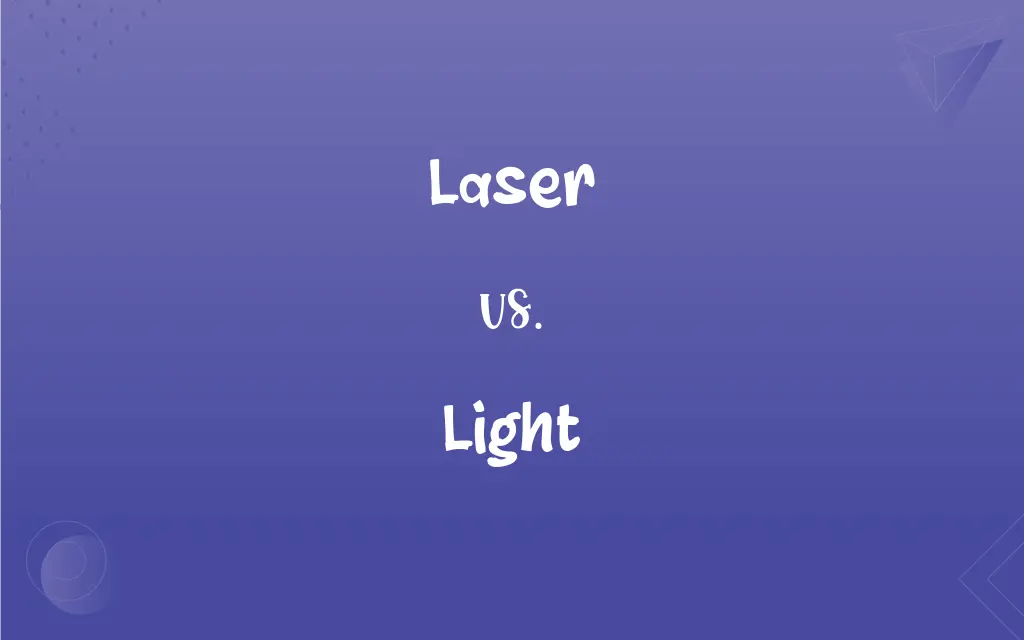Laser vs. Light: What's the Difference?
Edited by Janet White || By Harlon Moss || Updated on October 4, 2023
A laser emits coherent, monochromatic light, while light is a broad spectrum of electromagnetic radiation visible to the human eye.

Key Differences
A laser, which stands for Light Amplification by Stimulated Emission of Radiation, is a device that produces an intense beam of coherent monochromatic light. The specific nature of lasers allows them to focus on tiny spots with immense energy. This characteristic of lasers distinguishes them from regular sources of light. By harnessing the properties of stimulated emission, lasers can maintain a consistent wavelength of light, making them remarkably precise.
On the other hand, light is a form of electromagnetic radiation that's perceivable by the human eye. Spanning a spectrum that encompasses violet to red, light is a natural phenomenon that illuminates our world. While light sources like the sun, light bulbs, or candles emit a broad spectrum of these wavelengths, a laser restricts its emission to a very narrow range, hence its monochromatic nature.
In terms of coherence, a laser's emitted light waves are in phase with one another. This coherence ensures that the light produced by lasers can travel long distances without much dispersion. Comparatively, regular light sources like bulbs emit incoherent light. This means the waves produced by such sources are out of phase, leading to a rapid spreading out or dispersion of light.
The applications of lasers and light also differ immensely due to their properties. Lasers, with their precision, are used in various fields ranging from medical surgeries to reading digital discs in devices. Light, being ubiquitous, is essential for vision, photosynthesis in plants, and setting our biological clocks, among many other functions.
In summation, while both lasers and light are essential in their respective domains, they differ in coherence, spectrum, and applications. Lasers emit focused, monochromatic beams, while light encompasses a broad spectrum of visible radiation.
ADVERTISEMENT
Comparison Chart
Nature
Coherent and monochromatic
Broad spectrum of visible wavelengths
Origin of Name
Acronym for Light Amplification by Stimulated Emission of Radiation
Derived from Old English 'lēoht' meaning illumination
Dispersion
Minimal due to coherence
More dispersion as it's incoherent
Applications
Surgery, reading digital discs, etc.
Vision, photosynthesis, illumination, etc.
Emission
Stimulated emission
Natural or artificial sources like the sun, bulbs
ADVERTISEMENT
Laser and Light Definitions
Laser
An instrument that amplifies light based on the principle of stimulated emission.
The scientist adjusted the laser to get the desired intensity and focus.
Light
Electromagnetic radiation visible to the human eye.
The light from the sun brightens our day.
Laser
A device producing intense light through stimulated emission.
Surgeons use lasers for precise cutting during operations.
Light
A medium that makes objects visible by reflecting off them.
Without light, we would be enveloped in darkness.
Laser
A beam of light with coherent and monochromatic properties.
The laser pointer produced a consistent red dot on the presentation slide.
Light
The condition of being visible or known.
The investigation brought the truth to light.
Laser
An artificial light source with the ability to focus on minute spots.
Lasers have revolutionized eye surgeries, offering clear vision without glasses.
Light
A symbol or manifestation of enlightenment or knowledge.
She was seen as the light of reason in a chaotic meeting.
Laser
A technological tool emitting a powerful, narrow beam of light.
The barcode scanner uses a laser to read product information.
Light
A source of illumination, natural or artificial.
The room was bathed in the soft light of the lamp.
Laser
Any of several devices that emit highly amplified and coherent radiation of one or more discrete wavelengths. One of the most common lasers makes use of atoms in a metastable energy state, which, as they decay to a lower energy level, stimulate others to decay, resulting in a cascade of emitted radiation.
Light
Electromagnetic radiation that is visible, perceivable by the normal human eye as colors between red and violet, having frequencies between 400 terahertz and 790 terahertz and wavelengths between 750 nanometers and 380 nanometers. Also called visible light.
Laser
A beam of radiation emitted by a laser.
Light
Electromagnetic radiation of any frequency or wavelength.
Laser
(Sports)A ball or puck sent in a straight line at high speed
Shot a laser into the upper right corner of the goal.
Light
The sensation of perceiving light; brightness
A sudden light that made me blink.
Laser
A device that produces a monochromatic, coherent beam of light.
Light
A source of light, especially a lamp, a lantern, or an electric lighting fixture
Turn out the lights when you leave.
FAQs
How is light perceived by humans?
Light is perceived by humans when it enters the eye and strikes the retina.
Is laser light different from regular light?
Yes, laser light is coherent and monochromatic, while regular light has a broad spectrum.
Are lasers only used in medical procedures?
No, lasers have a wide range of applications, including communication, entertainment, and industry.
Does light have energy?
Yes, light carries energy, which can be absorbed or emitted by matter.
What does laser stand for?
Laser stands for Light Amplification by Stimulated Emission of Radiation.
What is the primary source of natural light on Earth?
The primary source of natural light on Earth is the sun.
Can lasers be of different colors?
Yes, lasers can be of different colors based on their specific wavelengths.
What's the speed of light in a vacuum?
The speed of light in a vacuum is approximately 299,792,458 meters per second.
How are lasers used in communication?
Lasers are used in optical fiber communication to transmit data at high speeds.
What is white light made of?
White light is a combination of all colors in the visible spectrum.
Can lasers carry data?
Yes, lasers are used to transmit data, especially in optical fiber networks.
How do lasers produce light?
Lasers produce light through a process called stimulated emission.
How does light help plants?
Light is essential for photosynthesis, a process where plants make food.
Is light a wave or a particle?
Light exhibits properties of both waves and particles, described by wave-particle duality.
Can lasers be dangerous?
Yes, certain powerful lasers can be harmful, especially to the eyes.
Which travels faster, light or sound?
Light travels faster than sound.
Why are lasers used in eye surgeries?
Lasers provide precision, reducing damage to surrounding tissues during eye surgeries.
How do prisms affect light?
Prisms can refract and disperse light, separating it into its constituent colors.
How does light travel?
Light travels in straight lines as waves.
Are all lasers harmful to the eyes?
Not all, but direct exposure to powerful lasers can damage the eyes.
About Author
Written by
Harlon MossHarlon is a seasoned quality moderator and accomplished content writer for Difference Wiki. An alumnus of the prestigious University of California, he earned his degree in Computer Science. Leveraging his academic background, Harlon brings a meticulous and informed perspective to his work, ensuring content accuracy and excellence.
Edited by
Janet WhiteJanet White has been an esteemed writer and blogger for Difference Wiki. Holding a Master's degree in Science and Medical Journalism from the prestigious Boston University, she has consistently demonstrated her expertise and passion for her field. When she's not immersed in her work, Janet relishes her time exercising, delving into a good book, and cherishing moments with friends and family.































































